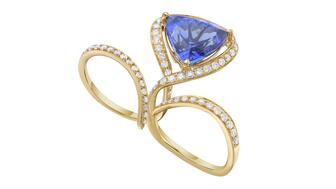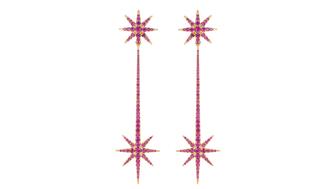Carlos Jose Hernandez and Joshua Zuazo were sentenced to life without the possibility of parole in the 2024 murder of Hussein “Sam” Murray.
Rocks On: Pink’s popularity boosts morganite
As interest in pink stones has picked up over the last decade, morganite demand and price have been lifted with it while supply struggles to keep pace.

When musician and actress Jennifer Lopez got engaged to actor Ben Affleck back in 2002, he proposed with a 6.1-carat pink Harry Winston diamond that was estimated to be worth $1.2 million.
After that, the popularity of pink stones rose rapidly--diamonds and sapphires in the hue have been having their day ever since and, along with them, morganite, said Simon Watt of gemstone dealer Mayer & Watt.
As pink shades begin to trend, especially for engagement rings, morganite offers a great value proposition for those looking for stone in the shade at a lower price point than sapphires.
“We’re selling morganite like hot cakes,” Watt said. “It’s selling very well right now. It could be a good option for an engagement ring for those looking for color, and it’s a nice hard stone.”
Robert Weldon, manager of photography and visual communications at the Gemological Institute of America and a colored gemstone expert, confirmed that they too have seen an increase of morganite on the market, especially over the last year or so.
He attributed part of the stone’s upward trend to Pantone’s naming of “Marsala” as the color of the year and the popularity of color blocking the lighter pink shades of stones like morganite with the darker hues of the earthy red marsala.
The pink beryl--which generally is lesser known than the two popular varieties of beryl, emeralds and aquamarines--was everywhere during the Tucson gem shows in February, given an extra boost in popularity and price over the past few years.
“There are always some colors that really resonate with customers, and I don’t know what it is but right now (morganite is) really doing that,” gemstone supplier James Alger, of James Alger Co., said. “It has a really pleasant color.”
A shifted focus
High-quality morganite offering the best saturation of color traditionally has come from Madagascar and Nigeria, but many said they are seeing less of that material available.
Rather, Brazil has popped up as the most significant source of morganite in the current market.
Since irradiation mimics a process that can be done in nature, there’s no way to tell if the morganite has been treated in a lab. However, the irradiation process doesn’t change anything about the stability or hardness of the gemstone, so it continues with its rising popularity in the market.
Weldon too said that since much of the morganite currently available on the market is pretty uniform in color, and nature doesn’t generally make it that way that often, it’s a likely indication that much of it has, in fact, been irradiated.
He added that he’s been hearing that people are beginning to re-process the tailings from the mines where morganite previously had been found to see if they can find any stones in the discarded ore.
Steeper price tags
Regardless of origin, the price of morganite of all types has skyrocketed over the past few years, bridging the gap between the natural African material and what dealers are asking for the Brazilian stones.
Allen Dolberg of jewelry manufacturer Zoma Color said that he’s seen prices of the Brazilian material increase from an average of $15 to $20 per carat to somewhere between $50 and $70 per carat over the past year.
As demand and price increase, it stands to reason that supply should be waning, which is what a few of the gemstone dealers have been noticing of late.
“The Tucson show last year was ridiculous,” Dolberg, referring to the morganite supply. “There were pounds of it. This February, though, there seemed to be less. It seems that demand is using up supply.”
Dolberg notes that though he’s seeing plenty of morganite in finished goods, it’s becoming harder and harder to find the actual loose stones these days. “Dealers are seeing less available, and the price is going up, so we can deduce from that the supply is down,” he added.
The pinker morganite stones entered the market fairly recently, with availability popping up about 12 months ago, whereas Dolberg said he’s seen peach in larger numbers for the past five years.
The demand for and popularity of the peach hues has, in fact, fed into trends for other colored stones.
Over the last six months, Dolberg has seen tremendous demand for peach sapphires as well, which he believes comes from morganite rather than the other way around, as “no one really wanted it before.”
Watt too noted that there was a lot more peach morganite on the market for a few years but that more of the vivid pink has been appearing lately.
For Mayer & Watt, the highest demand currently for morganite in general is for 2- to 5-carat pieces, and the average price is around $45 to $95 per carat for their inventory.
Large and in charge
Morganite’s color comes out best in the larger stones, and that’s a good thing considering it’s one of the few gems that is more readily available in larger sizes.
“We’ve seen dealers with trays of 40- to 50-carat pieces of morganite,” Dolberg said. “You don’t often see those size in other materials.”
Despite that, the standard calibrated sizes still are what they sell most, he said.
The difference between what kind of morganite jewelers might be looking for depends on the customer type--for those looking for the finest quality and who want to be sure of what’s been done (or, rather, hasn’t been done) to their morganite, the natural material from Madagascar is all that will do.
For others, the irradiated material from Brazil provides a great color that’s worth the value.
No matter which jewelers pick, it doesn’t appear that the demand for morganite will be slowing down any time soon.
“We think pinks will trend more and more based on last year, and we’re sort of surprised at its success over the last five years,” Dolberg said. “We think it’s really established itself in the marketplace.”
The Latest

Yood will serve alongside Eduard Stefanescu, the sustainability manager for C.Hafner, a precious metals refiner in Germany.

The New Orleans jeweler is also hosting pop-up jewelry boutiques in New York City and Dallas.

How Jewelers of America’s 20 Under 40 are leading to ensure a brighter future for the jewelry industry.

Set in a Tiffany & Co. necklace, it sold for $4.2 million, the highest price and price per carat paid for a Paraíba tourmaline at auction.


The jeweler’s “Deep Freeze” display showcases its iconic jewelry designs frozen in a vintage icebox.

Take luxury gifting to new heights this holiday season with the jeweler’s showstopping 12-carat sphene ring.

Roseco’s 704-page catalog showcases new lab-grown diamonds, findings, tools & more—available in print or interactive digital editions.

This year's theme is “Unveiling the Depths of the Ocean.”

In its annual report, Pinterest noted an increase in searches for brooches, heirloom jewelry, and ‘80s luxury.

Starting Jan. 1, customers can request the service for opal, peridot, and demantoid garnet.

The 111-year-old retailer celebrated the opening of its new location in Salem, New Hampshire, which is its third store in the state.

The new catalog features its most popular chains as well as new styles.

The filmmaker’s personal F.P. Journe “FFC” prototype was the star of Phillips’ recent record-setting watch auction in New York.

The new location in the Design District pays homage to Miami’s Art Deco heritage and its connection to the ocean.

Inflations, tariffs, and politics—including the government shutdown—were among consumers’ top concerns last month.

“Longtime favorite” presenters, as well as first-time speakers, will lead talks and workshops at the annual event in Tucson next year.

Silas Smith of Meridian Metalworks won the challenge with his pendant that blends Australian and American landscapes.

The sale of the 31.68-carat, sunset-hued stone was part of Sotheby’s first series of events and auctions in Abu Dhabi.

Most customers who walk into your store this month have made up their minds. Your job is to validate their choice, Emmanuel Raheb writes.

The collection features characters and motifs from Ukrainian folklore, including an enchanted mirror and a magic egg.

MatrixGold 3.11, the newest version of the jewelry design program, offers more flexibility, precision, and creative control.

The pavilion will be part of the 2026 JA New York Spring show, scheduled for March 15 to 17.

Kadet, a 1994 National Jeweler Retailer Hall of Fame inductee, helped grow the family-owned retailer in the Chicago area and beyond.

Billed as the world’s smallest wearable, Lumia Health’s new smart earrings have a health tracker subtly embedded in the back.

Don’t let those with December birthdays feel blue. Help them celebrate their month with blue zircon, turquoise, and tanzanite.

The new pink sapphire version of the piece dances with its wearer in the brand’s “Icons After Dark” holiday campaign.

























